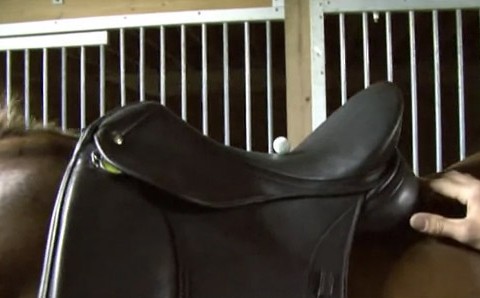Hi, my name is Jochen Schleese and I am here today to tell you about saddle fit, and what you can do to protect your horse so nothing will happen to your horse like mine who has to be layed up because of long-term damage. Today we are going to use Ted, a beautiful quarter horse. You can see (in the video) a couple of irritations and saddle fitting damage such as: white hair, a stress line, and a holding line. What I would like to show you today is how you can help your horse and check your own saddles. So lets start with a 9 point check.
STEP 1: BALANCE
The first thing I like to do is start with the balance. The best way is to take the saddle pad and the irons off, go to your horse, and put the saddle on the withers and slide it right back behind the shoulder blade. A little test for horses with mutton withers: where the end of the mane is, go straight down and find the edge of the shoulder blade. So one more time, if you put the saddle on, you slide it on right behind that point of the shoulder blade and that’s your starting point.
You’re looking for the balance first, a good indication on a dressage saddle is that the cantle should be a little higher from top to cantle. Using a golf ball or piece of chalk, you want to make sure that the piece sits somewhat in the middle, parallel to the ground. If the chalk rolls too far forward, the cantle is too high. If the saddle is to low in the back, the chalk will roll back, making it very difficult for the horse or you to balance yourself properly.
Lets talk a little bit more about what happens when the balance is off. Lets say the saddle is too high in the back or too low in the front: the pressure would go all the way into the shoulder and it would pinch very hard on the side of the withers. What happens to the rider? You fall forward then when you try to correct this; you lean back and lift your leg creating problems in your lower disk and put both you and your horse in a very uncomfortable position.
What would happen in the other situation when the saddle is too high in the front or too low in the back? All the weight would go over the last two floating ribs. A lot of pressure through the back, making it very difficult for the horse to bring its back up. And again for the rider, the leg would go up because you feel like you are falling back and when trying to correct this, you try to sit over your leg and ride with rolled shoulders forward.
What is the advantage for the saddle to be balanced? Well for the horse, the weight of the rider is distributed over a large area, it doesn’t get shot forward into the shoulder or the loin. For the rider, when your standing, your standing over your feet with four curves in your back acting as shock absorbers. When sitting in a balanced saddle, with the weight of your seat bones you can now keep your posture as if you were standing. You can sit back or lean forward without your lower legs or upper legs swinging back and forth. It’s an advantage for both the horse and rider when the saddle is balanced!

